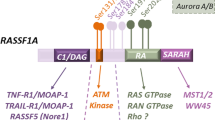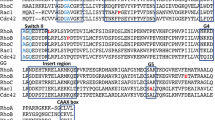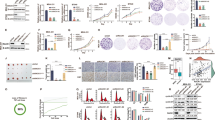Abstract
RACK1 is a highly conserved intracellular adaptor protein with significant homology to Gβ and was originally identified as the anchoring protein for activated protein kinase C. In the past 20 years, the number of binding partners and validated cellular functions for RACK1 has increased, which facilitates clarification of its involvement in different biological events. In this review, we will focus on its role in cancer, summarizing its aberrant expression, pro- or anti-oncogenic effects and the underlying mechanisms in various cancers.
This is a preview of subscription content, access via your institution
Access options
Subscribe to this journal
Receive 50 print issues and online access
$259.00 per year
only $5.18 per issue
Buy this article
- Purchase on Springer Link
- Instant access to full article PDF
Prices may be subject to local taxes which are calculated during checkout




Similar content being viewed by others
References
Guillemot F, Billault A, Auffray C . Physical linkage of a guanine nucleotide-binding protein-related gene to the chicken major histocompatibility complex. Proc Natl Acad Sci USA 1989; 86: 4594–4598.
Ron D, Chen CH, Caldwell J, Jamieson L, Orr E, Mochly-Rosen D . Cloning of an intracellular receptor for protein kinase C: a homolog of the beta subunit of G proteins. Proc Natl Acad Sci USA 1994; 91: 839–843.
Daniels CC, Rovnak J, Quackenbush SL . Walleye dermal sarcoma virus Orf B functions through receptor for activated C kinase (RACK1) and protein kinase C. Virology 2008; 375: 550–560.
Wehner P, Shnitsar I, Urlaub H, Borchers A . RACK1 is a novel interaction partner of PTK7 that is required for neural tube closure. Development 2011; 138: 1321–1327.
Li J, Guo Y, Feng X, Wang Z, Wang Y, Deng P et al. Receptor for activated C kinase 1 (RACK1): a regulator for migration and invasion in oral squamous cell carcinoma cells. J Cancer Res Clin Oncol 2012; 138: 563–571.
Berns H, Humar R, Hengerer B, Kiefer FN, Battegay EJ . RACK1 is up-regulated in angiogenesis and human carcinomas. FASEB J 2000; 14: 2549–2558.
Rosdahl JA, Mourton TL, Brady-Kalnay SM . Protein kinase C delta (PKCdelta) is required for protein tyrosine phosphatase mu (PTPmu)-dependent neurite outgrowth. Mol Cell Neurosci 2002; 19: 292–306.
Hermanto U, Zong CS, Li W, Wang LH . RACK1, an insulin-like growth factor I (IGF-I) receptor-interacting protein, modulates IGF-I-dependent integrin signaling and promotes cell spreading and contact with extracellular matrix. Mol Cell Biol 2002; 22: 2345–2365.
Ron D, Jiang Z, Yao L, Vagts A, Diamond I, Gordon A . Coordinated movement of RACK1 with activated betaIIPKC. J Biol Chem 1999; 274: 27039–27046.
Chang BY, Conroy KB, Machleder EM, Cartwright CA . RACK1, a receptor for activated C kinase and a homolog of the beta subunit of G proteins, inhibits activity of src tyrosine kinases and growth of NIH 3T3 cells. Mol Cell Biol 1998; 18: 3245–3256.
Kraus S, Gioeli D, Vomastek T, Gordon V, Weber MJ . Receptor for activated C kinase 1 (RACK1) and Src regulate the tyrosine phosphorylation and function of the androgen receptor. Cancer Res 2006; 66: 11047–11054.
Mamidipudi V, Dhillon NK, Parman T, Miller LD, Lee KC, Cartwright CA . RACK1 inhibits colonic cell growth by regulating Src activity at cell cycle checkpoints. Oncogene 2007; 26: 2914–2924.
Lu F, Zhang C, Wu WJ, Wu YM . RACK1 downregulation suppresses migration and proliferation of neuroblastoma cell lines. Oncol Rep 2012; 27: 1646–1652.
Peng R, Jiang B, Ma J, Ma Z, Wan X, Liu H et al. Forced downregulation of RACK1 inhibits glioma development by suppressing Src/Akt signaling activity. Oncol Rep 2013; 30: 2195–2202.
Guo Y, Wang W, Wang J, Feng J, Wang Q, Jin J et al. Receptor for activated C kinase 1 promotes hepatocellular carcinoma growth by enhancing mitogen-activated protein kinase kinase 7 activity. Hepatology 2013; 57: 140–151.
Vomastek T, Iwanicki MP, Schaeffer HJ, Tarcsafalvi A, Parsons JT, Weber MJ . RACK1 targets the extracellular signal-regulated kinase/mitogen-activated protein kinase pathway to link integrin engagement with focal adhesion disassembly and cell motility. Mol Cell Biol 2007; 27: 8296–8305.
Belozerov VE, Ratkovic S, McNeill H, Hilliker AJ, McDermott JC . In vivo interaction proteomics reveal a novel p38MAPK/Rack1 pathway regulating proteostasis in Drosophila muscle. Mol Cell Biol 2014; 34: 474–484.
López-Bergami P, Habelhah H, Bhoumik A, Zhang W, Wang LH, Ronai Z . RACK1 mediates activation of JNK by protein kinase C [corrected]. Mol Cell 2005; 19: 309–320.
Bird RJ, Baillie GS, Yarwood SJ . Interaction with receptor for activated C-kinase 1 (RACK1) sensitizes the phosphodiesterase PDE4D5 towards hydrolysis of cAMP and activation by protein kinase C. Biochem J 2010; 432: 207–216.
Link AJ, Eng J, Schieltz DM, Carmack E, Mize GJ, Morris DR et al. Direct analysis of protein complexes using mass spectrometry. Nat Biotechnol 1999; 17: 676–682.
Ceci M, Gaviraghi C, Gorrini C, Sala LA, Offenhäuser N, Marchisio PC et al. Release of eIF6 (p27BBP) from the 60S subunit allows 80S ribosome assembly. Nature 2003; 426: 579–584.
Shor B, Calaycay J, Rushbrook J, McLeod M . Cpc2/RACK1 is a ribosome-associated protein that promotes efficient translation in Schizosaccharomyces pombe. J Biol Chem 2003; 278: 49119–49128.
Baum S, Bittins M, Frey S, Seedorf M . Asc1p, a WD40-domain containing adaptor protein, is required for the interaction of the RNA-binding protein Scp160p with polysomes. Biochem J 2004; 380: 823–830.
Sengupta J, Nilsson J, Gursky R, Spahn CM, Nissen P, Frank J . Identification of the versatile scaffold protein RACK1 on the eukaryotic ribosome by cryo-EM. Nat Struct Mol Biol 2004; 11: 957–962.
Kiely PA, Sant A, O’Connor R . RACK1 is an insulin-like growth factor 1 (IGF-1) receptor-interacting protein that can regulate IGF-1-mediated Akt activation and protection from cell death. J Biol Chem 2002; 277: 22581–22589.
Zhang W, Zong CS, Hermanto U, Lopez-Bergami P, Ronai Z, Wang LH . RACK1 recruits STAT3 specifically to insulin and insulin-like growth factor 1 receptors for activation, which is important for regulating anchorage-independent growth. Mol Cell Biol 2006; 26: 413–424.
Lee HS, Millward-Sadler SJ, Wright MO, Nuki G, Al-Jamal R, Salter DM . Activation of Integrin-RACK1/PKCalpha signalling in human articular chondrocyte mechanotransduction. Osteoarthritis Cartilage 2002; 10: 890–897.
Liliental J, Chang DD . Rack1, a receptor for activated protein kinase C, interacts with integrin beta subunit. J Biol Chem 1998; 273: 2379–2383.
Usacheva A, Smith R, Minshall R, Baida G, Seng S, Croze E et al. The WD motif-containing protein receptor for activated protein kinase C (RACK1) is required for recruitment and activation of signal transducer and activator of transcription 1 through the type I interferon receptor. J Biol Chem 2001; 276: 22948–22953.
Isacson CK, Lu Q, Karas RH, Cox DH . RACK1 is a BKCa channel binding protein. Am J Physiol Cell Physiol 2007; 292: C1459–C1466.
Kiely PA, Leahy M, O’Gorman D, O'Connor R . RACK1-mediated integration of adhesion and insulin-like growth factor I (IGF-I) signaling and cell migration are defective in cells expressing an IGF-I receptor mutated at tyrosines 1250 and 1251. J Biol Chem 2005; 280: 7624–7633.
Feng C, Li YF, Yau YH, Lee HS, Tang XY, Xue ZH et al. Kindlin-3 mediates integrin αLβ2 outside-in signaling, and it interacts with scaffold protein receptor for activated-C kinase 1 (RACK1). J Biol Chem 2012; 287: 10714–10726.
Buensuceso CS, Obergfell A, Soriani A, Eto K, Kiosses WB, Arias-Salgado EG et al. Regulation of outside-in signaling in platelets by integrin-associated protein kinase C beta. J Biol Chem 2005; 280: 644–653.
Besson A, Wilson TL, Yong VW . The anchoring protein RACK1 links protein kinase Cepsilon to integrin beta chains. Requirements for adhesion and motility. J Biol Chem 2002; 277: 22073–22084.
Kiely PA, Baillie GS, Lynch MJ, Houslay MD, O’Connor R . Tyrosine 302 in RACK1 is essential for insulin-like growth factor-I-mediated competitive binding of PP2A and beta1 integrin and for tumor cell proliferation and migration. J Biol Chem 2008; 283: 22952–22961.
McCahill A, Warwicker J, Bolger GB, Houslay MD, Yarwood SJ . The RACK1 scaffold protein: a dynamic cog in cell response mechanisms. Mol Pharmacol 2002; 62: 1261–1273.
Cao XX, Xu JD, Liu XL, Xu JW, Wang WJ, Li QQ et al. RACK1: a superior independent predictor for poor clinical outcome in breast cancer. Int J Cancer 2010; 127: 1172–1179.
Cao XX, Xu JD, Xu JW, Liu XL, Cheng YY, Wang WJ et al. RACK1 promotes breast carcinoma proliferation and invasion/metastasis in vitro and in vivo. Breast Cancer Res Treat 2010; 123: 375–386.
Al-Reefy S, Mokbel K . The role of RACK1 as an independent prognostic indicator in human breast cancer. Breast Cancer Res Treat 2010; 123: 911 author reply 912.
Lacombe J, Mangé A, Jarlier M, Bascoul-Mollevi C, Rouanet P, Lamy PJ et al. Identification and validation of new autoantibodies for the diagnosis of DCIS and node negative early-stage breast cancers. Int J Cancer 2013; 132: 1105–1113.
Shi S, Deng YZ, Zhao JS, Ji XD, Shi J, Feng YX et al. RACK1 promotes non-small-cell lung cancer tumorigenicity through activating sonic hedgehog signaling pathway. J Biol Chem 2012; 287: 7845–7858.
Zhong X, Li M, Nie B, Wu F, Zhang L, Wang E et al. Overexpressions of RACK1 and CD147 associated with poor prognosis in stage T1 pulmonary adenocarcinoma. Ann Surg Oncol 2013; 20: 1044–1052.
Nagashio R, Sato Y, Matsumoto T, Kageyama T, Satoh Y, Shinichiro R et al. Expression of RACK1 is a novel biomarker in pulmonary adenocarcinomas. Lung Cancer 2010; 69: 54–59.
Ruan Y, Sun L, Hao Y, Wang L, Xu J, Zhang W et al. Ribosomal RACK1 promotes chemoresistance and growth in human hepatocellular carcinoma. J Clin Invest 2012; 122: 2554–2566.
Deng YZ, Yao F, Li JJ, Mao ZF, Hu PT, Long LY et al. RACK1 suppresses gastric tumorigenesis by stabilizing the β-catenin destruction complex. Gastroenterology 2012; 142: 812–823 e15.
Hu F, Tao Z, Wang M, Li G, Zhang Y, Zhong H et al. RACK1 promoted the growth and migration of the cancer cells in the progression of esophageal squamous cell carcinoma. Tumour Biol 2013; 34: 3893–3899.
Wang Z, Zhang B, Jiang L, Zeng X, Chen Y, Feng X et al. RACK1, an excellent predictor for poor clinical outcome in oral squamous carcinoma, similar to Ki67. Eur J Cancer 2009; 45: 490–496.
McLeod M, Shor B, Caporaso A, Wang W, Chen H, Hu L . Cpc2, a fission yeast homologue of mammalian RACK1 protein, interacts with Ran1 (Pat1) kinase To regulate cell cycle progression and meiotic development. Mol Cell Biol 2000; 20: 4016–4027.
Wu J, Meng J, Du Y, Huang Y, Jin Y, Zhang J et al. RACK1 promotes the proliferation, migration and invasion capacity of mouse hepatocellular carcinoma cell line in vitro probably by PI3K/Rac1 signaling pathway. Biomed Pharmacother 2013; 67: 313–319.
Sutton P, Borgia JA, Bonomi P, Plate JM . Lyn, a Src family kinase, regulates activation of epidermal growth factor receptors in lung adenocarcinoma cells. Mol Cancer 2013; 12: 76.
Zhang D, Wang Q, Zhu T, Cao J, Zhang X, Wang J et al. RACK1 promotes the proliferation of THP1 acute myeloid leukemia cells. Mol Cell Biochem 2013; 384: 197–202.
Kraft C, Vodermaier HC, Maurer-Stroh S, Eisenhaber F, Peters JM . The WD40 propeller domain of Cdh1 functions as a destruction box receptor for APC/C substrates. Mol Cell 2005; 18: 543–553.
Li Y, Peart MJ, Prives C . Stxbp4 regulates DeltaNp63 stability by suppression of RACK1-dependent degradation. Mol Cell Biol 2009; 29: 3953–3963.
Subauste MC, Ventura-Holman T, Du L, Subauste JS, Chan SL, Yu VC et al. RACK1 downregulates levels of the pro-apoptotic protein Fem1b in apoptosis-resistant colon cancer cells. Cancer Biol Ther 2009; 8: 2297–2305.
Gomez-Bougie P, Bataille R, Amiot M . Endogenous association of Bim BH3-only protein with Mcl-1, Bcl-xL and Bcl-2 on mitochondria in human B cells. Eur J Immunol 2005; 35: 971–976.
Harada H, Quearry B, Ruiz-Vela A, Korsmeyer SJ . Survival factor-induced extracellular signal-regulated kinase phosphorylates BIM, inhibiting its association with BAX and proapoptotic activity. Proc Natl Acad Sci USA 2004; 101: 15313–15317.
Zhang W, Cheng GZ, Gong J, Hermanto U, Zong CS, Chan J et al. RACK1 and CIS mediate the degradation of BimEL in cancer cells. J Biol Chem 2008; 283: 16416–16426.
Sang N, Severino A, Russo P, Baldi A, Giordano A, Mileo AM et al. RACK1 interacts with E1A and rescues E1A-induced yeast growth inhibition and mammalian cell apoptosis. J Biol Chem 2001; 276: 27026–27033.
Choi DS, Young H, McMahon T, Wang D, Messing RO . The mouse RACK1 gene is regulated by nuclear factor-kappa B and contributes to cell survival. Mol Pharmacol 2003; 64: 1541–1548.
Wu Y, Wang Y, Sun Y, Zhang L, Wang D, Ren F et al. RACK1 promotes Bax oligomerization and dissociates the interaction of Bax and Bcl-XL. Cell Signal 2010; 22: 1495–1501.
Mamidipudi V, Cartwright CA . A novel pro-apoptotic function of RACK1: suppression of Src activity in the intrinsic and Akt pathways. Oncogene 2009; 28: 4421–4433.
Serrels B, Sandilands E, Serrels A, Baillie G, Houslay MD, Brunton VG et al. A complex between FAK, RACK1, and PDE4D5 controls spreading initiation and cancer cell polarity. Curr Biol 2010; 20: 1086–1092.
Trerotola M, Li J, Alberti S, Languino LR . Trop-2 inhibits prostate cancer cell adhesion to fibronectin through the β1 integrin-RACK1 axis. J Cell Physiol 2012; 227: 3670–3677.
Mourton T, Hellberg CB, Burden-Gulley SM, Hinman J, Rhee A, Brady-Kalnay SM . The PTPmu protein-tyrosine phosphatase binds and recruits the scaffolding protein RACK1 to cell-cell contacts. J Biol Chem 2001; 276: 14896–14901.
Hellberg CB, Burden-Gulley SM, Pietz GE, Brady-Kalnay SM . Expression of the receptor protein-tyrosine phosphatase, PTPmu, restores E-cadherin-dependent adhesion in human prostate carcinoma cells. J Biol Chem 2002; 277: 11165–11173.
Cao XX, Xu JD, Xu JW, Liu XL, Cheng YY, Li QQ et al. RACK1 promotes breast carcinoma migration/metastasis via activation of the RhoA/Rho kinase pathway. Breast Cancer Res Treat 2011; 126: 555–563.
Dave JM, Kang H, Abbey CA, Maxwell SA, Bayless KJ . Proteomic profiling of endothelial invasion revealed receptor for activated C kinase 1 (RACK1) complexed with vimentin to regulate focal adhesion kinase (FAK). J Biol Chem 2013; 288: 30720–30733.
He X, Wang J, Messing EM, Wu G . Regulation of receptor for activated C kinase 1 protein by the von Hippel-Lindau tumor suppressor in IGF-I-induced renal carcinoma cell invasiveness. Oncogene 2011; 30: 535–547.
Li G, Ji XD, Gao H, Zhao JS, Xu JF, Sun ZJ et al. EphB3 suppresses non-small-cell lung cancer metastasis via a PP2A/RACK1/Akt signalling complex. Nat Commun 2012; 3: 667.
Buensuceso CS, Woodside D, Huff JL, Plopper GE, O’Toole TE . The WD protein Rack1 mediates protein kinase C and integrin-dependent cell migration. J Cell Sci 2001; 114: 1691–1698.
Cox EA, Bennin D, Doan AT, O'Toole T, Huttenlocher A . RACK1 regulates integrin-mediated adhesion, protrusion, and chemotactic cell migration via its Src-binding site. Mol Biol Cell 2003; 14: 658–669.
Ikebuchi Y, Ito K, Takada T, Anzai N, Kanai Y, Suzuki H . Receptor for activated C-kinase 1 regulates the cell surface expression and function of ATP binding cassette G2. Drug Metab Dispos 2010; 38: 2320–2328.
Ikebuchi Y, Takada T, Ito K, Yoshikado T, Anzai N, Kanai Y et al. Receptor for activated C-kinase 1 regulates the cellular localization and function of ABCB4. Hepatol Res 2009; 39: 1091–1107.
Gallina A, Rossi F, Milanesi G . Rack1 binds HIV-1 Nef and can act as a Nef-protein kinase C adaptor. Virology 2001; 283: 7–18.
Boner W, Morgan IM . Novel cellular interacting partners of the human papillomavirus 16 transcription/replication factor E2. Virus Res 2002; 90: 113–118.
Kubota T, Yokosawa N, Yokota S, Fujii N . Association of mumps virus V protein with RACK1 results in dissociation of STAT-1 from the alpha interferon receptor complex. J Virol 2002; 76: 12676–12682.
Severino A, Baldi A, Cottone G, Han M, Sang N, Giordano A et al. RACK1 is a functional target of the E1A oncoprotein. J Cell Physiol 2004; 199: 134–139.
Seidl P, Huettinger R, Knuechel R, Kunz-Schughart LA . Three-dimensional fibroblast-tumor cell interaction causes downregulation of RACK1 mRNA expression in breast cancer cells in vitro. Int J Cancer 2002; 102: 129–136.
Acknowledgements
This work was supported by the National Basic Research Program of China (2010CB912102), Ministry of Science and Technology Key Program (2012ZX10002009-017), the National Natural Science Foundation of China (81230058, 30930023, 31100551, 31201046, 81021002), CAS/SAFEA International Partnership Program for Creative Research Teams, Shanghai Institutes for Biological Sciences, Chinese Academy of Sciences (SIBS2012004) and Technology Commission of Shanghai Municipality (12XD1405600) to DX. This work was also supported by the Young Scientist Fund of National Science Foundation of China (31201046) and Sanofi-Aventis-Sibs Scholarship Program (2011) to J-JL.
Author information
Authors and Affiliations
Corresponding author
Ethics declarations
Competing interests
The authors declare no conflict of interest.
Rights and permissions
About this article
Cite this article
Li, JJ., Xie, D. RACK1, a versatile hub in cancer. Oncogene 34, 1890–1898 (2015). https://doi.org/10.1038/onc.2014.127
Received:
Revised:
Accepted:
Published:
Issue Date:
DOI: https://doi.org/10.1038/onc.2014.127
This article is cited by
-
Loss of DJ-1 function contributes to Parkinson’s disease pathogenesis in mice via RACK1-mediated PKC activation and MAO-B upregulation
Acta Pharmacologica Sinica (2023)
-
TRIM26 inhibited osteosarcoma progression through destabilizing RACK1 and thus inactivation of MEK/ERK signaling
Cell Death & Disease (2023)
-
RACK1 facilitates breast cancer progression by competitively inhibiting the binding of β-catenin to PSMD2 and enhancing the stability of β-catenin
Cell Death & Disease (2023)
-
CircVPRBP inhibits nodal metastasis of cervical cancer by impeding RACK1 O-GlcNAcylation and stability
Oncogene (2023)
-
A new KSRP-binding compound suppresses distant metastasis of colorectal cancer by targeting the oncogenic KITENIN complex
Molecular Cancer (2021)



